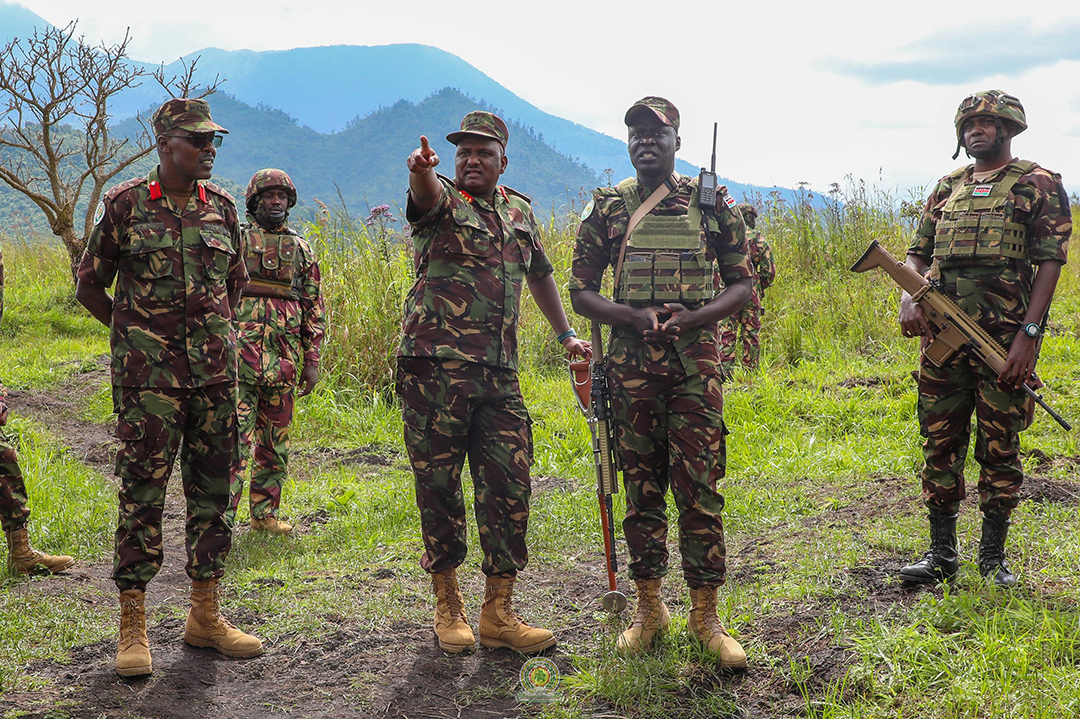Fully Deployed Regional Force Starting to Impact Eastern DRC
ADF STAFF
After six months of delays and logistical challenges, the East African Community Regional Force (EACRF) completed its full deployment in the Democratic Republic of the Congo (DRC) on April 3.
Thousands of Soldiers have arrived with a mission to bring order to chaos in the eastern provinces that have been plagued by violence from more than 120 armed groups.
“EACRF is reposturing its troops within Rutshuru and Masisi territories, making North Kivu a multinational sector,” the force said in a February 10 statement that called for the immediate deployment of all committed troops.
East African Community (EAC) military chiefs agreed to send Soldiers to areas previously held by M23 rebels to oversee a phased withdrawal and to protect civilians. They reiterated a warning that all armed groups in the DRC should lay down their weapons or be attacked by the forces of the entire region.
EAC leaders first approved deploying a new regional force on June 20, 2022, but it took until November 2022 for about 1,000 Kenyan troops to be the first of four promised contingents to arrive in North Kivu province’s capital, Goma.
After reemerging from a 10-year dormancy in 2021, the Tutsi-led M23 staged a major offensive in 2022, seizing large chunks of North Kivu territory and forcing hundreds of thousands of people from their homes.
The DRC and independent United Nations experts have accused Rwanda of supporting the M23, which Rwanda has denied.
When Kenyan forces arrived in 2022, the Congolese expected that the EACRF would quickly rout the M23 rebels and drive them from territories that they had occupied for months.
But to the dismay of DRC government officials, the regional military leaders insisted that they were not authorized to engage the rebels in combat.
For several weeks in March, there was no major fighting between Congolese forces and M23, but the rebels were accused of summarily executing civilians and battled frequently with local pro-government militias.
As of April 5, the EACRF has yet to fire a shot, according to the newspaper The East African, but its increasing presence is making a difference.
Kenya airlifted Burundi’s first contingent of about 100 Soldiers to Goma on March 5. They deployed to the nearby town of Sake about 15 kilometers to the west and were promptly attacked by M23 rebels seeking to surround the city.
After additional Burundian troops arrived on March 15, the contingent pushed further west to take over key locations previously occupied by M23 rebels. The troops were expected to turn north of Sake to Kitchanga, another key commerce hub.
“M23 has withdrawn from Sake, Karuba, Mushaki, Neenero, Kirolirwe, Kibirizi, Mweso and adjacent areas,” the EACRF said in a March 23 statement.
On April 2 and 3, Kenya airlifted the South Sudan contingent of 340 Soldiers to Goma, which marked the final phase of the regional bloc’s deployment.
Tanzania’s commitment to deploying troops as part of the EACRF is unclear. But at last count in 2022, about 866 Tanzanian personnel were active in the U.N. peacekeeping mission in the DRC (MONUSCO).
Since arriving in Goma, the EACRF has secured critical infrastructure, including the international airport and its surrounding areas, which are full of impromptu refugee camps.
Reports say displaced people began making “a significant return” to their homes in March, as trade and supply routes reopened and humanitarian aid began to flow through liberated territories.
On April 4, EACRF Commander Maj. Gen. Jeff Nyagah met with his MONUSCO counterpart to establish collaboration in operational boundaries, airspace control, logistical support, the opening of key supply routes, and intelligence sharing and monitoring.
In the months before the EACRF achieved full deployment, multiple cease-fires with M23 failed. Now, with a larger force spreading through the area, there is hope that either Kenya- or Angola-led peace processes will bear fruit.
A fourth session of the Nairobi Process, between the DRC government and various armed groups, is expected to be held in Kinshasa by the end of April before moving to negotiations in the North Kivu, South Kivu and Ituri provinces.
The DRC considers M23 to be a terrorist group and refuses any dialogue before disarmament.
“The process in Eastern DRC has to be solved through political processes,” EAC Secretary-General Peter Mathuki said in February on the sidelines of an African Union event in Nairobi. “Our military [is] there to reinforce the political process.”
Uganda’s first of two EACRF contingents crossed into the DRC on March 31 with 1,000 Soldiers in vehicles and tanks. Three days later, the Ugandans declared the border town of Bunagana liberated after more than nine months of M23 occupation.
Trupti Agrawal, senior analyst for East Africa for the Economist Intelligence Unit, said M23’s withdrawal from Bunagana was one positive step in what is likely to be a long process.
“The pullout is a sign of progress on regional mediation efforts, but that itself is a highly fragile process,” she told The Associated Press.


Comments are closed.